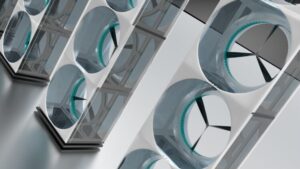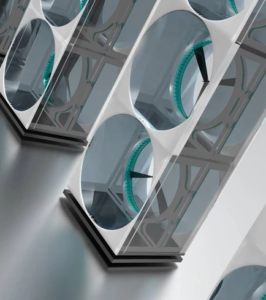Solar panels, a technology that dominated the renewable energy sector, could be facing their biggest challenge with the arrival of an innovative magnetic levitation wall. While technologies like transparent glass that generates energy even on cloudy days had already put solar panels in check, this new development promises to completely change the energy landscape: the magnetic levitation wall.
For years, roofs and open fields were colonized by solar panels and traditional wind turbines. However, technological evolution paved the way for more discreet and modular solutions, capable of generating energy in previously unthinkable places. One of these innovations is the magnetic levitation wall, which not only represents an advancement in efficiency but also could surpass the capabilities of current solar technologies.
The Peruvian start-up Eolic Wall has been developing a modular system inspired by the design of LEGO blocks for five years. This system allows stacking turbines on towers or walls through which the wind flows, generating electricity at high speed. Thanks to its scalable design, the installation can grow according to energy needs.
The system uses proprietary technology that combines an aerodynamic tunnel and widened blades to maximize wind capture. At its core, a magnetic propeller levitates, reducing friction and increasing energy efficiency. This design, based on an “arc flow generator,” promises an extended lifespan and reduced maintenance costs, making this alternative competitive against solar panels.

Challenges and Opportunities
Although Eolic Wall has not yet presented large-scale installations or detailed power data, the potential of this technology has already generated great enthusiasm. Similar prototypes, like the wind wall by designer Joe Doucet in New York, have shown that compact wind alternatives can supply average households with over 10,000 kWh per year.
The magnetic levitation wall represents one step further towards diversifying renewable energies, especially in urban and remote areas where traditional installations are unfeasible. As this technology evolves, a path opens up to complement and, perhaps, replace solar panels, consolidating a more sustainable energy future adapted to various needs.

Other Ways to Produce Wind Energy
Wind energy is generated through wind turbines, which are machines that transform the kinetic energy of the wind into electrical energy:
Operation
When the wind blows, the blades of the wind turbine rotate and activate a rotor, which transforms kinetic energy into mechanical energy. This mechanical energy is converted into electrical energy thanks to a generator that uses magnets.
Types of Wind Turbines
There are two types of wind turbines: horizontal-axis and vertical-axis. Horizontal-axis turbines are the most common and efficient. Vertical-axis turbines are omnidirectional and can be an advantage in places where wind direction is variable.
Production Process
The electricity produced by wind turbines is sent to an electrical substation, where its power is amplified. Finally, it is sent through the conventional electrical grid to homes.
Offshore Wind Energy
Also known as offshore wind energy, it is produced similarly to onshore wind energy, but in open waters. In this case, the wind encounters no natural geographical obstacles, making the energy production more productive.
Have you visited our YouTube channel yet? Subscribe now!

